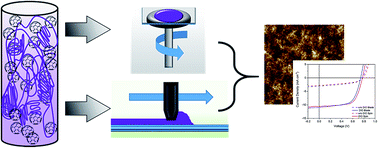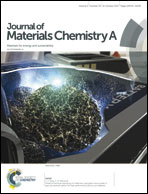Simple transfer from spin coating to blade coating through processing aggregated solutions†
Abstract
To develop an understanding of the effect spin coating or blade coating have on the morphology of polymer:fullerene thin films for organic solar cells, we have investigated the morphology of poly[5-(2-hexyldecyl)-1,3-thieno[3,4-c]pyrrole-4,6-dione-alt-5,5-(2,5-bis(3-dodecylthiophene-2-yl)-thiophene)] (P(T3-TPD)) blended with phenyl-C71-butyric acid methyl ester (PC71BM) using the solvent additive 1,8-diiodooctane (DIO). When P(T3-TPD) : PC71BM mixtures are cast with DIO, we observed a fivefold increase in power conversion efficiency (PCE) from 1% to >5% for both spin and blade coated devices. We found the morphology and OPV performance are remarkably similar for spin and blade coated films without having to re-optimize the processing solution or coating temperature. We attribute the robust coating behavior to processing an aggregated solution of P(T3-TPD) : PC71BM. Further, in order to gain insight into how the common solvent additive DIO enhances thin film morphology, in situ UV-vis absorbance and reflection spectroscopies, coupled with thin film morphology characterization, was performed to develop a mechanistic understanding of the solidification process. In situ and static measurements revealed that DIO increases the nucleation density, reducing domain size and additionally increases the polymer crystallinity and phase purity.



 Please wait while we load your content...
Please wait while we load your content...